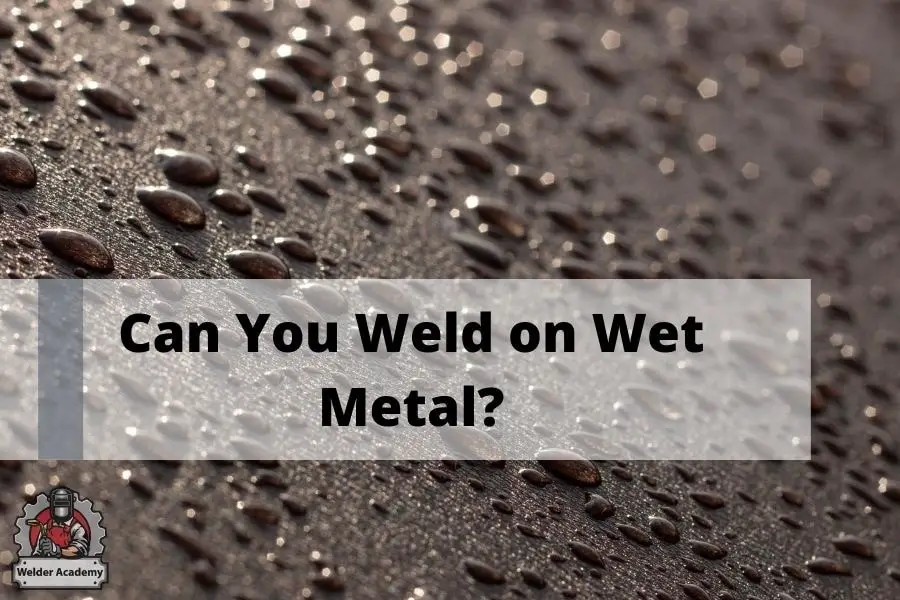
Welding is the way of combining metal pieces by superheating and melting them using electricity. However, it is not always possible to keep the metals dry all the time. And, as you know how electricity and water work, it is understandable to wonder, can you weld on wet metal?
Well, welding wet metals is possible. But it is extremely risky. Water conducts electricity and if you are not careful you can be electrocuted.
So, it is better to avoid welding wet materials altogether. But if you really have to do that, you must follow certain safety measures. So, in this article, I will discuss why it is not safe to weld on wet materials, along with some precautions and other information you might find helpful.
Can You Weld Wet Metals?
Technically, you can weld wet metals. However, some welding processes work well with wet metals, while others do not.
For example, it won’t matter if the metal is wet or not in stick welding. The water boiling point is much lower than the welding temperature in stick welding. So, in this type of welding, you won’t have to be concerned if you can ensure no contact with the arc or electrodes. However, if you want to ensure the highest welding quality, you must thoroughly clean it.
Now, MIG and TIG are less resistant to impurities, such as dampness and moisture. On the other hand, stick welding can be used on a far wider range of surfaces. If you weld with MIG on wet metals, the water might damage the bead, resulting in porosity.
Why Is Welding Wet Metal Dangerous?
Welding wet metal is dangerous because water and metal both are excellent electrical conductors. So, even if you can weld on wet metals, it is better to avoid it as it can cause serious electric shocks.
Electrocution is more likely when you do welding in the presence of moisture. The moisture of any kind, even your own sweats, can be dangerous. Well, many people wear proper gear before welding wet materials for safety. No doubt welding equipment is made to counteract the impacts of electricity. But water might make your gear wet, causing it to lose its safety.
Besides, as per the law of physics, electricity will always choose the path with the least amount of resistance. So, whether you wear rubber soles and heavy boots or not, you won’t be entirely safe. Even if a single part of your body comes into contact with a puddle of water on the welding metal, it will give you an electric shock, which can even lead to death.
How to Prepare Wet Metal for Welding?
It is better to prepare the wet metals before welding to reduce the chances of shock. You can dry off the metal, try to evaporate the moisture, and connect your ground to another source before starting to do welding.
Let’s discuss a few ways to prepare wet metal for welding:
1. Dry Off the Metal
You already know how dangerous it is to weld wet metals. So, it is better to dry off the metal before you start welding. Though it is not possible to completely dry off the metal, try to get as much moisture out of the metal as possible.
Cotton towels soak the most water from the steel and most other metals. Thus, I would recommend you to use them. Also, if you are not in a hurry, you can keep the metal out in the sun to completely dry it off.
However, keep in mind that your metals can get wet due to some external factors. So, it’s a good idea to find a means to protect the water from getting on the metals if it’s continually becoming wet due to some other external issue.
2. Evaporate the Existing Moisture
Even if your metal seems completely dry, it might still have some moisture. So, after you have dried the metal, let it rest for a few minutes to allow any remaining moisture to evaporate. At this step, you can use a fan to help speed things up. The fan will aid in the metal’s rapid drying.
It would be best if you use a powerful table fan or a floor fan that can move a lot of air and swiftly dry the metals.
3. Connect the Ground to a Secondary Source
Lastly, the best way to avoid electric shocks is to connect your ground to the metal you are welding. If you connect the ground to a secondary source, such as the welding table, the current will pass through the part and the table before grounding out entirely.
Precautions to Take Before Welding Wet Metals
Now, if you can’t dry off the wet metal and have no choice but to weld on it, you have to take proper safety measures. The following are some of the precautions you must take before welding on wet metals:
You must avoid exposing any area of your skin throughout the welding process. It is because you don’t want to put yourself in danger from any sparks or electricity that may occur throughout the procedure.
Even a small gap in your clothing might get you in contact with the wet metal and cause electric shocks. So, it is best to cover every portion of your body with clothing.
Wear the Right Gear
Whether you are welding wet metal or not, wearing proper gear is a must for any type of welding. Regular clothing is not sufficient to protect you from concealed welding threats. That’s why proper PPE is essential while welding.
You must wear safety goggles, a welding helmet, rubber boots, and gloves while welding to ensure your safety. Moreover, you must stay as dry as possible because being wet can significantly raise the risk of electrocution. So, use a raincoat and any waterproof apparel while welding wet metal.
Select A Proper Location for Work
Choose a well-ventilated area that isn’t prone to moisture or dampening. Moreover, don’t forget to inspect weld leads and your ground clamps for damage so that you don’t become a part of the electric circuit.
Use Rubber Mats
Standing on a rubber mat is another technique to add an extra layer of defense against getting electric shocks. No matter whether you are wearing high-quality work boots with a rubber sole or not, a rubber mat can give an additional layer of security. After all, standing in water while you are welding is pretty risky.
The rubber mat will not only help you avoid connection with any water surface but also keep you safe from being a component of an electrical circuit.
Keep your hands off the metal
The most important thing is avoiding contact with the wet metal. You must not touch the wet metal at any cost while welding.
Individuals often lean over or balance themselves against something to keep a steady hand. As I have mentioned earlier, while doing this, if you accidentally touch the wet metal you will get a terrible electric shock. So, try to keep your hands off the metal to avoid any unwanted events.
Besides all the above-mentioned precautions, it is better to have someone accompany you while you weld. It is better for your safety as the person can get you help if something goes wrong.
Conclusion
The welding process itself is pretty risky and trying to weld wet metals makes it even more dangerous. By now, you should understand whether or not can you weld on wet metal.
Although the answer is yes, I won’t recommend you to do this, especially if you are not a professional. Thanks for reading through. Take care and weld safe.

